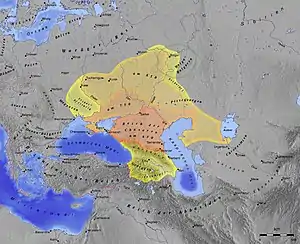| Battle of Balanjar | |||||||
|---|---|---|---|---|---|---|---|
| Part of the Arab–Khazar Wars | |||||||
| |||||||
| Belligerents | |||||||
| Khazar Khaganate | Rashidun Caliphate | ||||||
| Commanders and leaders | |||||||
| Unknown | Abd ar-Rahman ibn Rabiah † | ||||||
| Casualties and losses | |||||||
| 4,000 killed | |||||||
The Battle of Balanjar was a battle that took place during the First Khazar-Arab War between the armies of the Khazar Khaganate and the Caliphate, whose commanding general was Abd ar-Rahman ibn Rabiah.[1][2]
According to the Arab chroniclers, the Arabs captured Derbent in 642, when Abd al-Rahman ibn Rabiah secured the surrender of the Persian governor of Derbent, Shahrbaraz.[3] Based at Derbent, Abd al-Rahman led frequent raids against the Khazars over the following years, but these were small-scale affairs, and no event of major note is recorded in the sources.[4]
In 652, despite the orders of Caliph Uthman to avoid risks, Abd al-Rahman led a major invasion north, targeting the city of Balanjar.[5] According to Baladhuri and Ya'qubi, however, it was his brother Salman ibn Rabiah who led the invasion.[6]
In the subsequent siege, both sides made use of catapults and ballistae.[5] After several days, the Khazar garrison launched a sortie, which coincided with the arrival of a large Khazar relief army. After Abd al-Rahman was killed, the Arabs collapsed, despite the efforts of his brother, Salman, to rally them.[7] 4,000 Arabs were killed, many fled to Derbent with Salman, while others had to conduct a fighting retreat all the way to Gilan and Jurjan.[6][7]
The conflict Arab–Khazar wars between the Khazars and the Arabs (now under the Umayyad Caliphate) resumed after 707 with occasional raids back and forth across the Caucasus Mountains, intensifying after 721 into a full-scale war. Led by the prominent generals al-Jarrah ibn Abdallah and Maslama ibn Abd al-Malik, the Arabs recaptured Derbent and the southern Khazar capital of Balanjar; these successes had little impact on the nomadic Khazars, however, who continued to launch devastating raids deep into the South Caucasus. In a major 730 invasion, the Khazars decisively defeated Umayyad forces at the Battle of Ardabil, killing al-Jarrah; in turn, they were defeated the following year and pushed back north. Maslama then recovered Derbent, which became a major Arab military outpost and colony, before he was replaced by Marwan ibn Muhammad (the future caliph Marwan II) in 732. A period of relatively localized warfare followed until 737, when Marwan led a massive expedition north to the Khazar capital Atil on the Volga. After securing the submission of the Khazar ruler, the khagan, the Arabs withdrew.
See also
References
- ↑ Islam, Misbah (2008). Decline of Muslim States and Societies : The Real Root Causes and What Can Be Done Next. New Jersey: Xlibris Corporation. p. 325. ISBN 978-1-4363-1012-3.
- ↑ Howard-Johnston, J. D. (2010). Witnesses to a World Crisis : Historians and Histories of the Middle East in the Seventh Century. Oxford, England: Oxford University Press. p. 378. ISBN 978-0-19-920859-3.
- ↑ Dunlop 1954, pp. 47–49.
- ↑ Dunlop 1954, pp. 49–54.
- 1 2 Dunlop 1954, p. 55.
- 1 2 Artamonov 1962, p. 179.
- 1 2 Dunlop 1954, p. 56.
Sources
- Artamonov, M. I. (1962). История хазар [History of the Khazars] (in Russian). Leningrad: Издательство Государственного Эрмитажа. OCLC 490020276.
- Dunlop, Douglas M. (1954). The History of the Jewish Khazars. Princeton, New Jersey: Princeton University Press. OCLC 459245222.
